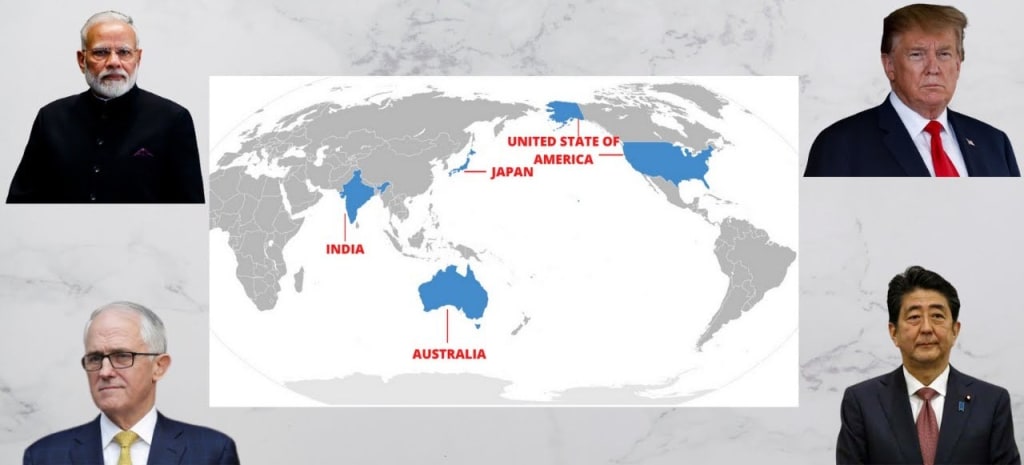The Formation of Quad Group and the Objectives of Indo-Pacific Engagement.
Quad aims to have a rule-based world order.

Quadrilateral Security Dialogue (Quad) is the informal strategic dialogue between India, the USA, Japan, and Australia to ensure a free, open, and prosperous Indo-Pacific region.
Before the Quad was initiated there was a Trilateral Strategic Dialogue (TSD) which had a series of trilateral meetings between the United States, Japan, and Australia. The TSD was upgraded to the ministerial level in 2005. The United States expected its regional allies to support its fight against terrorism and Japan and Australia expected the US involvement in strategic guarantees in the region. At the end of 2004 to help India during the Tsunami these countries together formed the Ad-hoc Tsunami core group.
The Quadrilateral Initiative
In early 2007, Prime Minister Abe proposed the Quadrilateral initiative under which India would join the multilateral dialogue with the remaining three countries.
Finally, a dialogue was initiated in 2007 by Prime Minister Shinzo Abe of Japan with the support of Vice President Dick Cheney of the US, Prime Minister John Howard of Australia, and Prime Minister Manmohan Singh of India. This was followed by a joint military exercise called the Exercise Malabar. The whole arrangement was seen as a response to the increasing Chinese economic and military might and the Chinese government responded to this by issuing diplomatic protests to the members.
The formation of Quad gave the impression that the move was aimed at encircling China. The move appeared to institutionally alienate China and the ASEAN and promote a Washington Centric alliance in Asia. The Japanese Prime Minister succeeding Abe, Taro Aso, downplayed the events stating,
“There was a mention of China- we do not have any assumption of a third country as a target such as China.”
Indian Foreign secretary also argued that the defense agreement was long overdue because of Indian freight trade with Japan and did not target China.
The Quad ceased with the withdrawal of Australia during the tenure of Kevin Rudd as prime minister due to its ambivalence in policy over the growing tension between the United States and China in the Asia Pacific. When Julia Gillard replaced Rudd in 2010 the cooperation resumed again leading to the placement of US marines near Darwin, Australia. Meanwhile, India, Japan, and the United States continued to hold the naval exercises through the Malabar.
When Donald Trump became the president of the United States, he visited Japan in November 2017 and agreed with Prime Minister Abe to pursue a free and open Indo-Pacific strategy. During the November 2017 ASEAN summit, all the four members rejoined the negotiations to revive the Quad to confront China militarily and diplomatically in the South China Sea. The meeting included discussions of China’s increased prominence in the South China Sea.
The Quadrilateral met five times in the period between 2017–2019. In 2018 during the dialogue in New Delhi, the navy chiefs of Japan, the US, Australia, and India came together indicating the revival of the Quad’s security structure. In March 2020, officials of the Quad met to discuss the COVID-19 pandemic. They were joined by New Zealand, South Korea, and Vietnam for the first time.
After the 2020 Malabar naval exercises, the American secretary of state Mike Pompeo met with members of the quad to discuss converting the security arrangement into an Asian NATO. The Chinese diplomat protested this as an attempt to wind back the clock of history; saying that it trumpets the cold war mentality, by attempting to stir confrontation among different groups and blocs and maintains the dominance and hegemony of the United States.
The problems facing Quad members –
The US is having a bitter trade dispute with China. Australia has been treated with cyber-attacks, economic coercion, and menacing language from China; Japan is being teased with routine transgressions by Chinese warplanes and naval ships, and Indian armed forces were locked in a faceoff with the Chinese along the Line of Actual Control. What was being feared in 2007 has played off fully in 2021, but the reactions till now have just been the dialogues.
Till now the Quad’s response has been ineffectual for the belligerent acts of the Chinese even though the Quad countries together have a combined GDP of $30 trillion and a defense budget of $800 billion. China has confronted militarily with the Quad countries simultaneously, expecting that they would remain mired in occasional dialogues, among all the disunited democracies.
One of the challenges facing Quad is the urgency facing each of the group members with regards to China while leaving aside their other foreign policy initiatives like Russia and Iran. India had close relations with both Russia and Iran and the Trump administration had to bully it with sanctions to force it away from Iran. This was without taking into consideration India’s regional calculus. Therefore for the Quad to succeed it should have a mandate of only containing China and forgetting relationships with other countries.
Motivations for various members for joining Quad:
USA
The US has described China along with Russia as a rival in its National Security Strategy. It has followed a policy to contain China’s increasing influence in East Asia and wants to use the coalition as an opportunity to regain its influence in the Asia Pacific region.
Australia
Australia has a great economic dependence on China. But it is increasingly getting concerned about China’s growing interest in its land, infrastructure, politics, and the influence on its universities.
Japan
Japan has good trade links with China and its exports to China contribute to one-third of Japan’s economic growth, but in the last decade, Japan has expressed concerns over Chinese transgressions in the region. It is therefore trying to balance its territorial and economic concerns with China and has agreed to participate in the Belt and Road initiative of China to develop infrastructure in third countries, as this can mitigate Chinese influence in these countries while at the same time improve Japan’s relations with China.
India
Till its dispute with China in 2020, India was carefully balancing China and the USA, all the while remaining committed to the strategic autonomy of China. But the faceoff along the Line of Control in 2020 has strained the relationships. China’s violation of international norms and its growing military and economic power pose a serious challenge for India.
Challenges for Quad
Economic Power of China
The economic might of China is continuously growing and it is expected to become the world’s largest economy by 2028. Japan and Australia have a dependence on China and can’t have strained relationships with it.
Territorial claims of China
China claims that it has historical ownership over the entire region of the South China Sea.
Aspirations of Quad members
The nations in the Quad group have varying aspirations to balance their interests. Therefore till now coherence as a group is missing.
The way forward and how to manage the situation
· The Quad group should not be just reactive and its members should ensure that the talk of free and open Indo-Pacific trade is more than a mere slogan.
· It should focus on building a regional consultation mechanism and coordinate with ASEAN nations on issues of regional importance.
· The group can take lead in the infrastructure projects in the region. The belt and road initiative project of China promises economic security but not human security as it has thrown a few countries into a debt trap. The Quad can play a role here as a group of democratic countries that can provide choice to nations as to where they want to borrow money.
· The only nation with big-enough naval power to rival China in this area is India and therefore it can bring peace, stability, and security to the region. Till now India has been reactive while China has made investments in Sri Lanka, Bangladesh, and Pakistan. Beijing has also invested heavily in the East Indian Ocean region up to Djibouti and Port Sudan. It is time for India to turn aggressive as the other members of the Quad are geographically cut off from the Indian Ocean region.
· Quad members can also benefit by the pooling together of their resources. It is up to the members to come together with their efforts when China is facing criticism for its role in the Covid-19 outbreak.
· A success in limiting China’s expansionist policies will set a precedent for the European Union as well and will go a long way in mitigating China’s threats on the international stage.
China which is observing the grouping of the Quad members against it would certainly react and prepare for retaliation. It could play a divide and rule policy which would mean creating conflicts among the members and reducing the pace of activities of the group.
Since the four members of Quad are all democracies, the diplomatic spin-offs will be great as their actions will be based on the universal principles of liberty and democracy which are much against the aggressive actions of a communist China. It is the only route now to blunt China’s actions.
The longer the actions against China are put off the more challenging it would become for the world to contain China. The approach of the Biden administration should be more conclusive as he has worked as vice president and seen the growth of the Dragon’s fangs due to the inconclusiveness of the world till now.






Comments
There are no comments for this story
Be the first to respond and start the conversation.